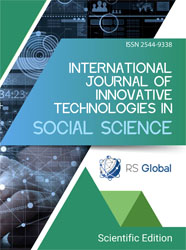THE BORDER CITY OF TÉBESSA: HISTORICAL DIMENSIONS AND CRITICAL REFLECTION
Abstract
This research engages in a thorough reflection on the city of Tébessa, a city located at the edges of its national territory and marked by a peripheral position, both geographically and symbolically. This reflection is centered around two fundamental and interdependent spatial concepts: "the city" and "the border." The main objective of this study is to examine the historical and contemporary interactions between these two dimensions, focusing on two key aspects: Tébessa's geographical position as a border city and the organization of its road network.
The analysis highlights the impact of the historical transformation of the border on the structure and function of the city. In the past, the border had a "zonal" and shifting form, allowing the ancient Theveste to play a central role in cross-border exchanges and interactions. In this context, the city served as a strategic hub, driven by economic, cultural, and social flows. However, with the evolution of borders into a "linear" and fixed form, Tébessa gradually lost its dynamic position, becoming a marginalized city, isolated and self-contained.
This transition not only affected Tébessa's identity and development but also reshaped its role in the regional space. Nevertheless, the border should not be seen solely as a constraint; it also represents a strategic opportunity. Indeed, Tébessa's border position could be reinvested to make it a hub for development and cross-border exchanges. With proper planning, the city could reinvent itself as a "transborder metropolis," capable of leveraging its geographical location to enhance its attractiveness, competitiveness, and integration into regional dynamics.
Thus, this study emphasizes that the border is not only a line of separation but also a space of potentialities. It can be viewed as a lever to reposition Tébessa with a forward-looking perspective, fostering a synergy between its historical heritage, economic dynamism, and strategic role in cross-border exchanges.
References
Abou-El-Kacim, Dellal, (2016) : « Tableau géographique de la frontière de l’Algérie », " in " revue académique des études sociales et humaines-A/ Sciences économiques et droit, n°15, janvier 2016, pp16- 23.
Albert M., 1998, “On Boundaries, territory and Postmodernity: an international relations perspective“, Geopolitics, n° 3, pp. 53-68.
Amilhat-Szary A.-L., Giraut F. (dir.), 2015, Borderities and the Politics of Contemporary Mobile Borders, Palgrave Macmillan, 308 p.
Anderson J., O’Dowd L., Wilson T.W. (ed.), 2004, New Borders for a Changing Europe: Cross-Border Cooperation and Governance, Londres, Frank Cases Publishers.
Balibar E., 2004, “Europe as borderland“, The Alexander von Humboldt Lecture in Human Geography, University of Nijmegen, November 10.
Belguidoum, Said, Olivier Pliez, (2012) : « Construire une route de la soie entre l’Algérie et la Chine », " in " Diasporas, Histoire et Sociétés, n° 20 (« Routes », sous la dir. de P. Cabanel), pp115-130.
Bevir M. (ed.), 2011, The Sage Handbook of Governance, Sage Publications, London, 576 p.
Bigo D. et Guild E., 2005, Controlling Frontiers. Free Movement Into and Within Europe, Ashgate, 283 p.
Blake G., 2000, “State limit in the early twenty-first century: observations on form and function“, Geopolitics, n° 5, pp. 1-18.
Blatter J., 2004, ‘From Spaces of Place’ to ‘Spaces of Flows’ ? Territorial and Functional Governance in Cross-border Regions in Europe and North America, International Journal of Urban and Regional Research, vol 28.3, septembre, pp. 530-548.
Doron, Adrien, (2015) :« De la marge au monde : la structuration mouvementée d’une place marchande transnationale à Ben Gardane (Tunisie) », Les Cahiers d’EMAM [En ligne], 26 2015, mis en ligne le 23 juillet 2015.
Dörry, S. & Decoville, A., 1 janv. 2016, Dans: European Urban and Regional Studies. 23, p. 69-85 20 p.
Foucher, Michel, (1988): « Fronts et frontières ; Un tour du monde géopolitique », Paris, Fayard, 691P.
Gsell, Stéphane, (1927) : « Histoire ancienne de l’Afrique du Nord : les royaumes indigènes organisation sociale, politique et économique », Paris, tome V, 290P.
Guichonnet, Paul et Raffestin Claude, (1974) : « Géographie des frontières », Paris : Presses universitaires de France, 224 P.
Lamour, C., 1 janv. 2014, Dans: Place Branding and Public Diplomacy. 10, 1, p. 19-31 10 p.
Leonard, Roger,(1952) : « Tébessa : l’antique Theveste », SEREE de Roche, conservateur du musée et des antiquités de Tébessa,78P. p19.
Moderoan, Yves, (2003): « les maures et l’Afrique romaine (IV-VII) », " in " Publication de l’école française de Rome. 2003, pp 445-540.
Monchicourt, Charles, (1938) : « La frontière algéro-tunisienne dans le Tell et dans la steppe », " in " revue Africaine, vol 82, pp 31-59, p59.
Political rescaling and metropolitan governance in cross-border regions: comparing the cross-border metropolitan areas of Lille and Luxembourg
Reitel, Bernard, Zander, Patricia, Piermay, Jean-Luc, Renard, Jean-Pierre, (2002),« Villes et frontière », Anthropos-Economica, Collection Villes,275P.
Renard, Jean-Pierre, (2012) : Conférence Doullens 18/4/2012. APHG Picardie, p03.
Schulz, Christian, (2002) :« L'agglomération Saarbrücken-Moselle-est : ville-frontière ou ville frontalière »," in " Bernard Reitel, Patricia Zander, Jean-Luc Piermay, Jean-Pierre Renard, Villes et frontières, Anthropos-Economica, Collection Villes, (2002), pp 51-61, p51.
Sohn, C. & Reitel, B., 1 juil. 2016, Dans: European Urban and Regional Studies. 23, p. 306-321 16 p.
Sohn, C., 1 janv. 2014, Dans: International Journal of Urban and Regional Research. 38, p. 1697-1711 20 p.
Sohn, Christophe, (2012) : « La frontière comme ressource dans l’espace urbain globalisé. Une contribution à l’hypothèse de la métropole transfrontalière », CEPS/INSTEAD – Luxembourg, Working Papers N° 2012-25, 37P, p15.
The Border as a Resource in the Global Urban Space: A Contribution to the Cross-border Metropolis Hypothesis.
Views:
443
Downloads:
407
Copyright (c) 2025 Sabah Chems Rifi, Salah Chaouche

This work is licensed under a Creative Commons Attribution 4.0 International License.
All articles are published in open-access and licensed under a Creative Commons Attribution 4.0 International License (CC BY 4.0). Hence, authors retain copyright to the content of the articles.
CC BY 4.0 License allows content to be copied, adapted, displayed, distributed, re-published or otherwise re-used for any purpose including for adaptation and commercial use provided the content is attributed.











